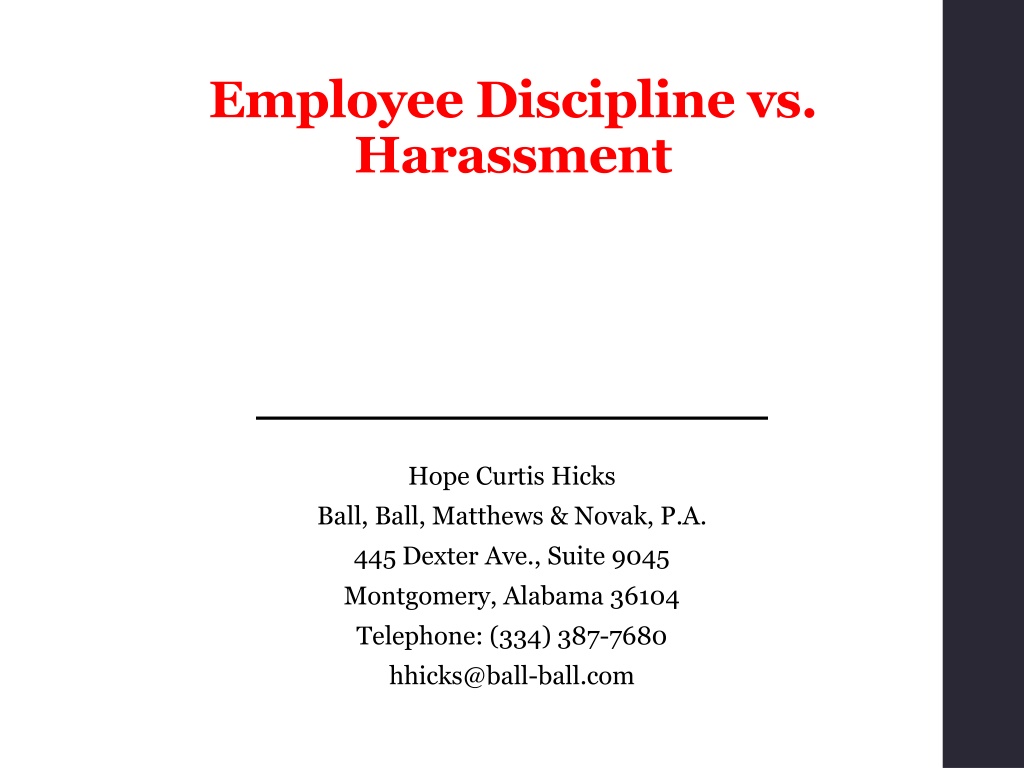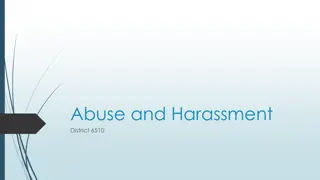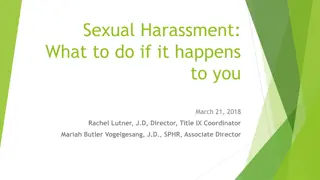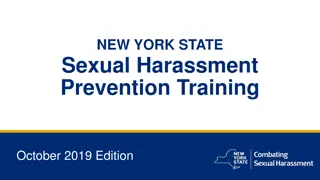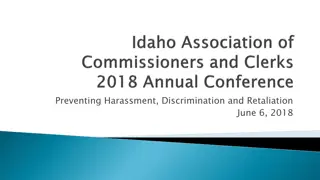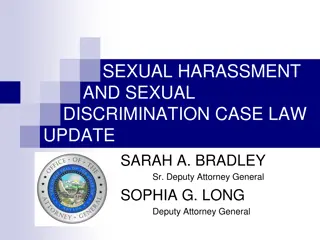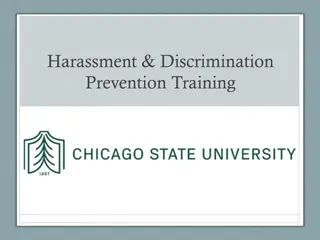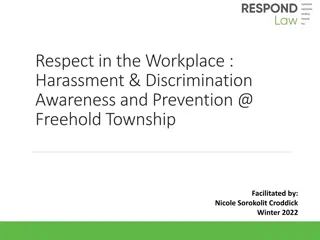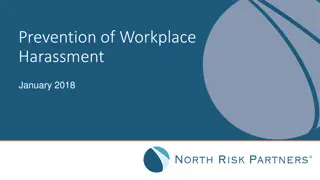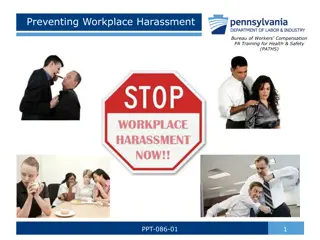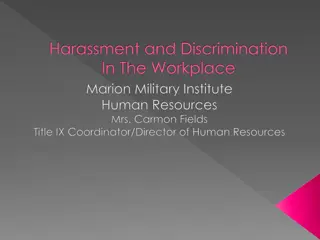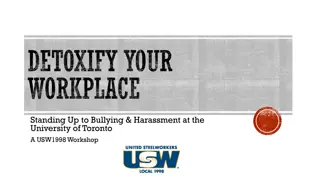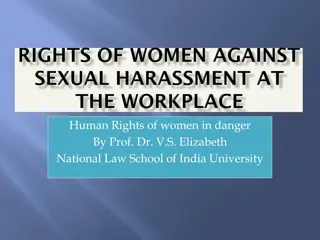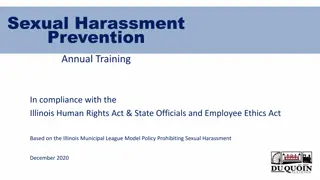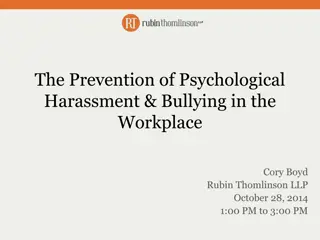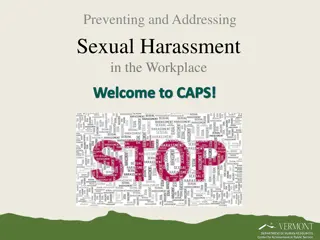Understanding Harassment and Discrimination Laws in the Workplace
Explore the laws surrounding harassment and discrimination in the workplace, including Title VII of the Civil Rights Act of 1964 and the Americans with Disabilities Act. Learn about protected classes and actions prohibited under these laws to ensure a fair and inclusive work environment.
Download Presentation

Please find below an Image/Link to download the presentation.
The content on the website is provided AS IS for your information and personal use only. It may not be sold, licensed, or shared on other websites without obtaining consent from the author. Download presentation by click this link. If you encounter any issues during the download, it is possible that the publisher has removed the file from their server.
E N D
Presentation Transcript
Employee Discipline vs. Harassment Hope Curtis Hicks Ball, Ball, Matthews & Novak, P.A. 445 Dexter Ave., Suite 9045 Montgomery, Alabama 36104 Telephone: (334) 387-7680 hhicks@ball-ball.com
Harassment and Discrimination: Applicable Laws Title VII of the Civil Rights Act of 1964 Age Discrimination in Employment Act Americans with Disabilities Act Genetic Information Non-Disclosure Act Equal Pay Act 42 U.S.C. 1981 First Amendment (public employers only) Fourteenth Amendment (public employers only) Pregnancy Discrimination Act
Harassment and Discrimination: Protected Classes May not harass or discriminate against an employee because of the employee s: Age (ADEA) Gender, including pregnancy (Title VII; PDA; 14th Amendment) Race/Color (Title VII; 14th Amendment; 42 U.S.C. 1981)
Harassment and Discrimination: Protected Classes May not harass or discriminate against an employee because of the employee s: Religion (Title VII; 14th Amendment) Disability (ADA) Genetic Conditions (GINA) National Origin (Title VII)
Harassment and Discrimination: Protected Classes In addition, public employers may not discriminate or harass employees who exercise their First Amendment rights of speech or association.
Protected Classes: Age The Age Discrimination in Employment Act ( ADEA ) protects all employees over the age of 40.
Protected Classes: Disability The Americans with Disabilities Act protects employees with both an actual or a perceived disability.
Protected Classes: Disability A disability is a: Physical or Mental Impairment That substantially limits One or more major life activities. May be perceived or actual
Protected Classes: Disability Must provide reasonable accommodations unless the employer can demonstrate undue hardship. Burden is on employee to request.
Protected Classes: First Amendment Rights May not discriminate against or harass employees because they exercise their rights to speech or association. These claims are brought pursuant to 42 U.S.C. 1983. COUNTY OFFICIALS AND EMPLOYEES MAY HAVE INDIVIDUAL LIABILITY FOR THESE CLAIMS.
Protected Classes: First Amendment Rights Association: Political association claims are the most common; however, any and all forms of association are protected (except criminal behavior). There is an exception allowing discrimination on the basis of political association for certain confidential positions.
Protected Classes: First Amendment Rights Employees who engage in speech as a citizen on a matter of public concern generally cannot be discriminated against or harassed because of this speech. Employees interest in speech must outweigh government s interests. Speech includes any expressive activity.
Harassment and Discrimination: What Behavior is Prohibited? Discrimination Treating people differently on the basis of a protected characteristic Harassment Words, conduct, or action (usually repeated or persistent) that, being directed at a specific person, annoys, alarms, or causes substantial emotional distress in that person and serves no legitimate purpose.
Prohibited Behavior: Discrimination Adverse Employment Action: Refusal to hire Failure to Promote Termination Suspension Demotion Other material changes in terms and conditions of employment
Prohibited Behavior: Harassment Quid Pro Quo Submission to such conduct is made either an expressed or implied term or condition of an individual s employment; or, Submission to or rejection of such conduct by any individual is used as the basis for employment decision affecting an individual. Hostile Work Environment Interferes with the individual s work performance or creates a hostile, intimidating, or offensive work environment.
Prohibited Behavior: Harassment Harassment can take a variety of forms: verbal, visual, written or physical. May include jokes, pictures, cartoons, statements, etc.
Prohibited Behavior: Retaliation May not retaliate against an employee who reports alleged harassment or discrimination. Retaliatory behavior is broader than an adverse employment action and includes any behavior that would tend to discourage employees from reporting harassment or discrimination.
Harassment and Discrimination: Legal Framework Direct Evidence Circumstantial Evidence Prima Facie Case Non-discriminatory reason for adverse action Employee must prove that reason is pretextual Defenses include: Mixed-Motive, After- Acquired Evidence
Harassment and Discrimination: Legal Framework For suits brought under Title VII, ADEA, ADA, employees must first file a claim with the EEOC. May not file lawsuit until receipt of Notice of Right to Sue. EEOC cannot directly bring action against local government; Department of Justice must do it.
Harassment and Discrimination: EEOC Requirements EEOC has very strict record-keeping requirements. For example, applications for employment must be kept for one year from the date of the personnel action involved. All records should be maintained appropriately.
Harassment and Discrimination: Policies and Training Must have an adequate anti-discrimination and anti-harassment training policy in place. Clearly state that discrimination and harassment will not be tolerated. Cover offensive behavior as well as illegal behavior. Simple reporting procedures.
Harassment and Discrimination: Policies and Training Must TRAIN all employees and supervisors on anti-discrimination and anti-harassment policy. Must post all required anti-discrimination and anti-harassment posters in visible areas.
Smith v. YOUR County Commission Title VII claims for gender discrimination and retaliation against the County Commission; 1983 claims for gender discrimination in violation of the 14th Amendment against the County Commission, each Commissioner, and you; Claim for retaliation in violation of FMLA against the County Commission; and, Claim for discrimination in violation of the ADA against the County Commission.
Smith v. YOUR County Commission: Meet Sue Smith Susan Smith is a 29 year old payroll clerk working in the Commission office. She has been employed for 5 years. Her work performance was very good for the first 3.5 years that she worked there, but then she started getting sloppy and making errors. She s started to get an attitude towards her co-workers, and has even started to be rude to members of the public.
RED FLAG NUMBER 1: Documentation! Did you document her performance and attitude problems as required by your policies? Did you document your discussions with her regarding these problems? Did you mention the problems in her evaluation?
Smith v. YOUR County Commission: The Beginning Sue s husband Bob is in the Reserves. He was injured in the line of duty. She ends up being out a total of four months (16 weeks) with him. Sue has enough sick time, vacation time, and comp time to cover about 6 weeks of leave. After that time, you put her on unpaid leave for the next 10 weeks.
RED FLAG NUMBER 2: FMLA! Has your FMLA policy been updated to clearly inform employees of their right to FMLA leave in order to care for a service member? Did you follow the correct procedures in processing the leave as FMLA leave? http://www.dol.gov/whd/ fmla/
Smith v. YOUR County Commission: Back at Work When Sue comes back to work, she starts falling back into her old ways. You cut her some slack after all, she s just had a very bad experience. Her performance remains very inconsistent for the next three months. She makes a couple of serious mistakes in payroll.
Smith v. YOUR County Commission: The Pregnancy Sue finally tells you that she s pregnant, and that she has developed problems with the pregnancy that will necessitate her missing a lot of work during the pregnancy. The problem, of course, is that she exhausted most of her leave six months ago when her husband was sick, plus she s already been out for 16 weeks this year.
RED FLAG NUMBER 3: FMLA and Unpaid Leave Did you process her previous leave as FMLA leave? What are your policies regarding payment of benefits for unpaid leave? Do you have a sick leave bank? How is that administered?
Smith v. YOUR County Commission: The Second to Last Straw Two weeks after you find out she s pregnant, Sue makes another big mistake in payroll. You re sick of it, so you write her up and suspend her for 2 days. She files an EEOC charge, alleging that you have discriminated against her because she is pregnant.
RED FLAG NUMBER 4: Discrimination Claims EEOC is going to ask for: Documentation of performance problems; Your policies; and, Evidence of differential treatment of other employees. Be aware of the possibility of retaliation claims!
Smith v. YOUR County Commission: The Last Straw Sue is out most of the time after filing the charge, and, when she is there, her performance is awful. She exhausts all her FMLA time, but the baby has been born, and she doesn t want to come back to work. She claims that she can no longer physically work all day, but you don t believe it. You have to have a payroll clerk, so you terminate her when she fails to return to work.
RED FLAG NUMBER 5: ADA Do you know how to identify and handle potential ADA violations? Did you investigate to see if there are any reasonable accommodations that would make her able to work? Do you have good job descriptions?
RED FLAG NUMBER 6: Termination Have you followed your termination procedures? Do you have clear documentation of all the problems?
RED FLAG NUMBER 7: Unemployment Compensation If you have reason to contest an employee receiving unemployment compensation, you should always do so. Do you have a system for monitoring unemployment compensation issues?
Smith v. YOUR County Commission: The Lawsuit The outcome depends largely on your: POLICIES ACTIONS DOCUMENTATION
